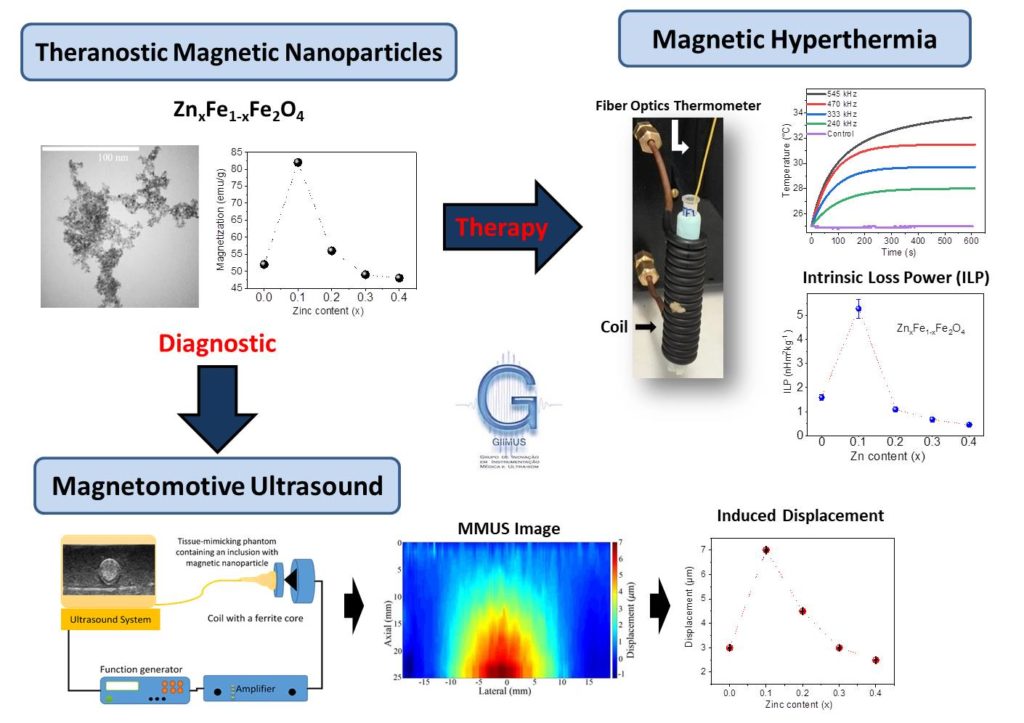Theranostics
The word “theranostic” comes from the combination of the words “therapy” and “diagnosis.” It means that when we talk about a theranostic agent or a theranostic platform, their use is both in therapy and in diagnosis. Theranostic agents are those that can be used both as a diagnostic agent, such as a contrast agent, and as a therapeutic agent, such as a drug or an agent that heats up under electromagnetic radiation. In our research group, the application of theranostic agents and platforms is through photoacoustic and magnetoacoustic techniques combined with magnetohyperthermia. Through the synthesis of theranostic agents, primarily magnetic and metallic nanoparticles (or a combination of both), we can use these as contrasts for photoacoustic and magnetoacoustic techniques and as therapeutic agents in magnetic hyperthermia.
Magnetohyperthermia
This phenomenon involves the increase in temperature of a magnetic material (magnetic nanoparticles) through an alternating magnetic field. It can be used as a therapeutic technique for the treatment of malignant neoplasms (cancer).
Magnetic hyperthermia is the phenomenon whereby the temperature of magnetic magnetic nanoparticles when subjected to an alternating magnetic field. This therapy consists of dispersing magnetic nanoparticles along a tumor tissue in which the aim is to raise the temperature. After the application of this magnetic field, heat is generated through different relaxation mechanisms. However, the success of this technique depends on several factors, such as the proper synthesis and characterization of the nanoparticles, their biocompatibility, performance evaluation under operating conditions, efficient delivery to the target tissue, temperature monitoring and safety limitation of the applied magnetic field.
Magnetomotive Ultrasound
Magnetomotive ultrasound is a technique that combines magnetism and ultrasound for applications involving magnetic nanoparticles. By using a coil, it is possible to generate a magnetic field that attracts the nanoparticles, and this displacement can be simultaneously detected by an ultrasound transducer positioned transversely to the coil. Therefore, this technique allows for the localization of magnetic nanoparticles in biological tissue, and through the ultrasonic waves generated by the displacement, we can also obtain information about the viscoelasticity of the tissue labeled with the nanoparticles. Hence, the technique can be used in conjunction with therapeutic methods utilizing magnetic nanoparticles, enhancing their precision.
Nanoparticles
Nanoparticles consist of particles of a specific material with dimensions in the order of nanometers (between 1×10-9 m and 100×10-9 m). They can be of different types and shapes, exhibiting theranostic action by serving as both contrast agents and therapeutic agents. In studies conducted by this research group, magnetic nanoparticles (particles responsive to magnetic fields) are primarily used for applications in magnetohyperthermia and magnetoacoustography techniques. Additionally, metallic nanoparticles such as gold nanoparticles are employed for photoacoustic purposes. These nanoparticles can be combined, either encapsulated with organic molecules or associated with other molecules, in nanostructures where all the aforementioned techniques can be applied.


Thiago Tiburcio
Master Student

Nicholas Zufelato
Postdoctoral Fellow

